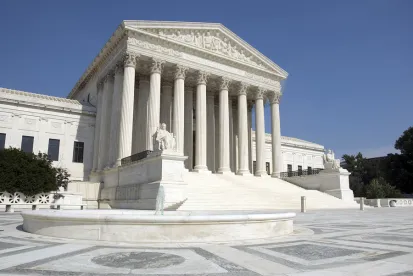Following confusion from a 2009 decision, the US Supreme Court on May 20, 2019, decided a significant impossibility preemption case. This new decision will change the dynamics of litigation involving the impossibility defense, and will introduce new litigation uncertainty due to a shift in the decision maker for impossibility preemption.
IN DEPTH
On May 20, 2019, in a unanimous judgment, the US Supreme Court decided Merck Sharp & Dohme Corp. v. Albrecht, No. 17-290, an important impossibility preemption case, and held that the judge, not the jury, must decide whether a state-law failure-to-warn claim is preempted because there is “clear evidence” that the Food and Drug Administration (FDA) would not have approved a change to a drug’s label to include the warning.
The Court’s decision in Albrecht comes on the heels of its decision in Wyeth v. Levine, 555 US 555 (2009), which held that a pharmaceutical manufacturer could escape liability under state-law failure-to-warn claims if the manufacturer could provide “clear evidence that the FDA would not have approved a change to [the drug’s] label.” Confusion blossomed after Wyeth in the lower courts as to how to apply the “clear evidence” standard and, importantly, whether the “clear evidence” decision was for the judge or the jury.
The Fosamax Litigation
Albrecht involved state-law claims for Merck’s alleged failure-to-warn about “atypical” femur fractures in consumers taking Fosamax, a drug that treats osteoporosis in postmenopausal women. In 2008, Merck sought FDA approval through the Prior Approval Supplement (“PAS”) process to add warnings to Fosamax’s label about “atypical” femur fractures in patients. The FDA did not approve Merck’s label change, and stated that there was “inadequate” justification for the new warning. Eventually, in 2011, the FDA did agree to the labeling change. But the interim years provided fertile ground for plaintiffs to sue Merck for failing to warn about the risk of “atypical” femur fractures.
In that litigation, Merck won summary judgment at the district court, arguing that the state-law claims were preempted because the FDA did not permit the label change that was at the heart of the failure-to-warn case. The US Court of Appeals for the Third Circuit reversed and held that the “clear evidence” standard from Wyeth was a factual burden of proof and required that Merck show by “clear and convincing” evidence that the FDA would have rejected the proposed warnings, that this determination is a question of fact for the jury and that there were material facts in dispute as to whether Merck could satisfy that standard.
The Court’s Decision and Concurring Opinions
In an opinion by Justice Stephen Breyer, the Supreme Court vacated and remanded the Third Circuit’s decision. The Court framed the issue as one of federal preemption and whether it was “impossible for a private party to comply with both state and federal requirements.” The state law at issue was the requirement for drug manufacturers to warn about risks of taking a particular drug. The federal law was the FDA’s regulation of the content of drug warning labels.
The Court explained that after a drug’s initial label is approved by the FDA, there are several ways in which a company can change that label if new or different warnings are needed as time passes. One way is called the “changes being effect” or “CBE” process, which allows a company to change a label without pre-approval by the FDA, though the FDA may review that change after it is made and approve or disapprove of it. Another method, the one used by Merck, is the PAS method, which requires the FDA’s pre-approval before the change can be made.
The Court explained that, under Wyeth, to succeed on the defense of impossibility preemption, the manufacturer must demonstrate that federal law—that is, the FDA after being fully informed regarding the justification for a label change—prohibited “the drug manufacturer from adding a warning that would satisfy state law.” The Court went on to explain that because the CBE process allows a manufacturer to make a label change without prior FDA approval, “a drug manufacturer will not ordinarily be able to show that there is an actual conflict between state and federal law such that it was impossible to comply with both.”
After providing that descriptive recitation of Wyeth, the Court proceeded to the normative portion of its decision, stating first that it would not further define Wyeth’s use of “clear evidence” in terms of evidentiary standards because the issue of preemption is one for the judge and not the jury, and the judge must “simply ask himself or herself whether the relevant federal and state laws ‘irreconcilably conflict.’” In coming to that conclusion on the “determinative question,” the Court relied upon its seminal patent litigation decision in Markman v. Westview Instruments, Inc., where it concluded that the construction of claims of a patent are for the judge not the jury to decide, to conclude that “judges, rather than lay juries are better equipped to evaluate the nature and scope of an agency’s determination” and whether the determination conflicts with state law. The Court acknowledged, as it did in Markman, that the legal question before the courts may contain contested facts, but those factual questions are “subsumed within an already tightly circumscribed legal analysis.” The Court then vacated the judgment of the Third Circuit because the Third Circuit incorrectly concluded that the preemption issue was one of fact, not law.
Although the judgment of the Court was unanimous, its reasoning was not. Justice Clarence Thomas, although he joined in the Court’s opinion, wrote a concurring opinion to explain his “understanding of the relevant pre-emption principles and how they apply to this case.” Justice Thomas explained that he remained “skeptical” that “physical impossibility” is the correct test. Instead, a logical contradiction test between state and federal law is the correct test under the original meaning of the Supremacy Clause. But even under the “physical impossibility” test, Justice Thomas would have concluded that Merck could not prevail because there was nothing that prevented Merck from using the CBE process to change the Fosamax label. And, even if Merck believed that the FDA would have ultimately disapproved of its label change under the CBE process, that “hypothetical” would not have rendered the earlier change impossible; “hypothetical agency action is not ‘Law.’”
Justice Samuel Alito, joined by Chief Justice John Roberts and Justice Brett Kavanaugh, only concurred in the judgment. Justice Alito explained that he agreed with the Court on the “only question that it actually decides”—namely, whether the preemption question is for the judge or jury. Justice Alito then discussed what he viewed to be critical omissions in both the discussion of the law and facts in the Court’s opinion in an effort to ensure that the Court’s opinion was not “misleading on remand.”
Key Takeaways
Much of the Court’s opinion in Albrecht focused on reiterating the Wyeth decision, with only a small portion devoted to answering the question presented: who decides the impossibility preemption question, the judge or jury. But, as can often be the case, the Court’s dictum provides interesting guidance to future litigants. One interesting issue not definitively answered in Albrecht is whether a manufacturer must use the CBE process now whenever it seeks to make a label change in hopes of preserving the impossibility preemption defense. The Court’s opinion does not go that far, however, only saying that because of the CBE process, manufacturers will not “ordinarily be able to show that there is an actual conflict between state and federal law such that it was impossible to comply with both.” Justice Thomas’s view suggests that the CBE process is required to preserve the preemption defense until such time as the FDA provides a final decision on the label change in accordance with its congressionally granted authority. In view of these statements in the Court’s opinion and Justice Thomas’s concurrence, it seems possible, if not likely, that many lower courts will simply default to a bright-line rule that requires manufacturers to use the CBE process—and for the FDA to thereafter disapprove the label warning alleged to be required by state law—to successfully invoke the impossibility defense.
Also important for litigants to understand is how the shift in the decision maker for impossibility preemption changes the dynamics of litigation involving that defense. Because impossibility preemption is now a question of law, with factual underpinnings, it will be subject to de novo review on appeal, making any decision by a district court on the issue much more susceptible to reversal. In the analogous context of construing patent claims as a matter of law under Markman, district court decisions are routinely reversed by the Federal Circuit. This specter of reversal of any district court decision in impossibility preemption brings litigation uncertainty to all the parties. We will closely be watching how these issues ultimately play out in the lower courts.




 />i
/>i

